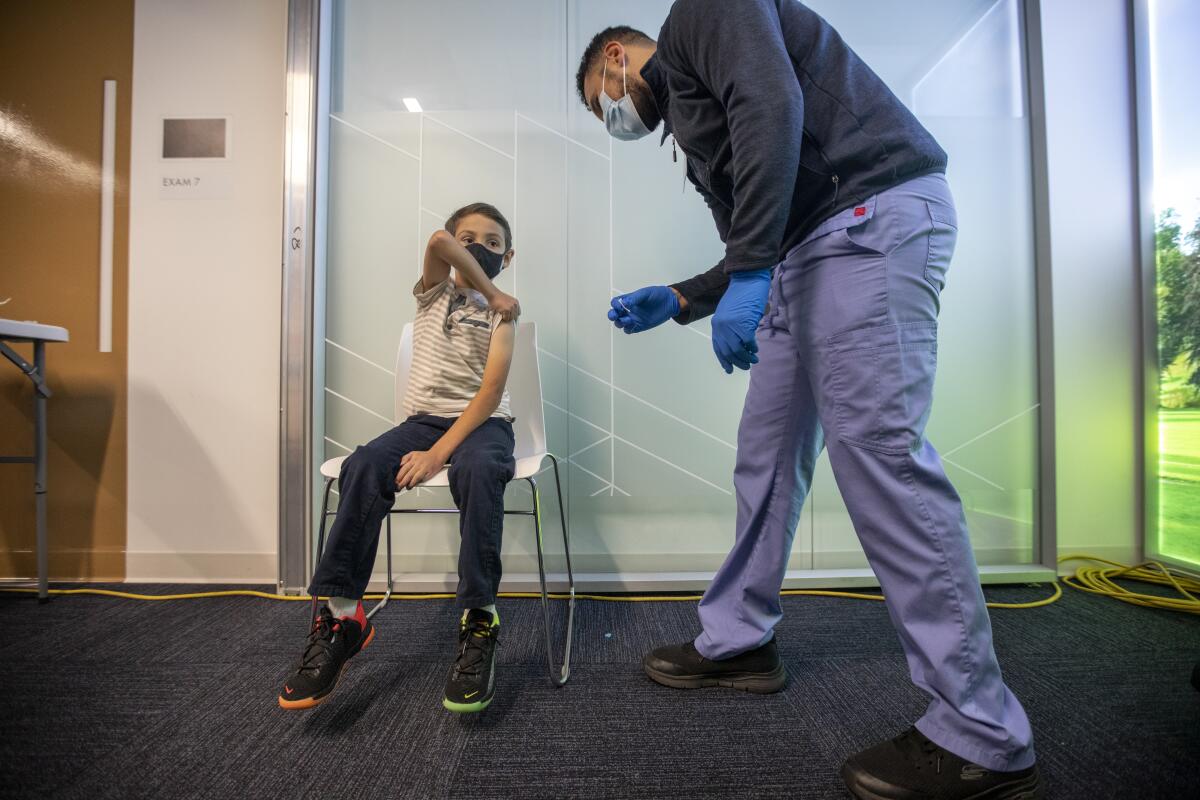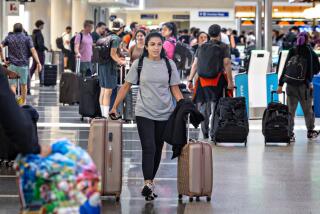Coachella, spring break and coronavirus: How to stay safe as COVID-19 cases rise

- Share via
With coronavirus cases increasing at a modest pace in Los Angeles County, health officials say it’s still a good idea to take measures to protect against getting infected.
Doctors have pointed out that getting infected continues to pose a risk of long COVID, in which symptoms of illness can persist for years, and put people at increased future risk for diabetes and heart disease.
Here are some tips to stay safer during spring break, the Easter holidays and Coachella Valley Music and Arts Festival:
Get up-to-date on your vaccines and boosters
There are still a lot of people in L.A. County who are eligible for their first booster shot but haven’t gotten boosted.
Among higher risk people, only 74% of vaccinated seniors age 65 and older eligible for a booster shot have received their first booster; the same is true for only 65% of vaccinated adults age 50 to 64, according to data shared by L.A. County Public Health Director Barbara Ferrer.
Which sets you should see, where you should eat and what you do and don’t need to bring to this year’s festival.
The U.S. Centers for Disease Control and Prevention recommends that everyone age 12 and up get at least one COVID-19 booster shot after completing the primary vaccination series.
Those age 50 and up are eligible for a second booster shot, as are immunocompromised people age 12 and up.
Make sure the people you’re spending time with are vaccinated and boosted
Yes, it might be a hassle. But asking people about their vaccination and booster shot status is especially important when people who are at higher risk for COVID-19 complications are attending an event.
Goldenvoice rescinded all COVID-19 safety protocols for the Coachella and country-themed Stagecoach festivals that will be held later this month in Indio.
Don’t travel or gather if you have symptoms of COVID-19
Some people might dismiss their symptoms as related to allergies — but it could be COVID-19.
Get tested, and regardless of the test result, stay at home if you’re sick. Sometimes, rapid tests can show negative test results when there’s too little virus in the body to be detected by the test; waiting more days could later show a positive test result.
Outdoor music festivals are considered safe, but some ticketholders are rethinking their Coachella attendance in wake of safety protocols being eliminated.
“If you are symptomatic, if you have a positive test, you’ll need to go back to using virtual strategies for connecting, so that you’re able to spread some cheer, but you’re not spreading the virus,” Ferrer said.
Take a coronavirus test if you’re going to be around people at high risk
If you’re going to be around others at higher risk for severe illness, Ferrer said, “it’s really important to go ahead and take that COVID-19 test before you meet up with them.”
And if you think you’ve been exposed to the coronavirus after you gather, get tested after the event, Ferrer said.
“Someone I know took a rapid COVID test before visiting a highly immunocompromised person. They were asymptomatic other than ‘allergy symptoms,’” tweeted Dr. Jeremy Faust, an emergency physician at Brigham and Women’s Hospital and an instructor at Harvard Medical School.
“The test was taken purely to protect the at-risk person. It was positive,” Faust wrote. “Rapid testing of asymptomatic people saves lives.”
At-home rapid coronavirus tests can be purchased at pharmacies and at online retailers.
People who are insured also have the ability to order eight at-home tests a month for every covered person on their health plan and get reimbursed for them by their health provider. The U.S. government began requiring insurance companies to reimburse for those tests beginning in mid-January.
In addition, every household in the U.S. is eligible to get two sets of four at-home tests mailed to them for free. People can order those tests at covidtests.gov or by calling (800) 232-0233. Many people ordered their first set of tests in January or February; the government allowed households to request a second set of free tests in March.
Gather outside when possible, and if not, open the windows
Keeping gatherings outside reduces risk of infection, Ferrer said.
“When that’s not doable, it’s best to have the gatherings be small. And you can improve the indoor flow of air by opening windows, doors and using fans strategically,” Ferrer said.
Wear a mask in indoor public settings
Even though it’s no longer required, Ferrer and state public health officials have continued to strongly recommend wearing masks in indoor public settings. Respirators, like KF94, KN95 and N95 masks, offer better protection.
If you test positive and you’re at high risk, seek an anti-COVID drug
Anti-COVID drugs are available to those who test positive and are at high risk, but it’s important that you know your coronavirus test status early on in the infection and seek the drugs promptly.
For people who do test positive, state health officials are saying that there is no longer a shortage of anti-COVID drugs in most locations.
“At this time, all outpatients with mild to moderate COVID-19 who are at risk for disease progression should be offered treatment, if eligible,” the California Department of Public Health said recently. People can seek prescriptions by calling their healthcare provider.
The U.S. government has launched a “Test to Treat” program, allowing people to get tested and get free anti-COVID pills at the same location, such as a pharmacy or clinic, as long as staff can either conduct a coronavirus test or evaluate an at-home test result and have on-site healthcare providers who can assess the patient.
A list of sites offering “Test to Treat” services in L.A. County can be found at ph.lacounty.gov/covidmedicines or by calling the county Department of Public Health at (833) 540-0473, between 8 a.m. and 8:30 p.m. seven days a week. They include certain CVS and Walgreens locations, as well as hospitals, clinics and local pharmacies. An L.A. County resident with a positive test can also get the drugs mailed to them at no cost by calling the same number.
For an L.A. County resident, “if you have an at-home test kit and you test yourself and you’re positive, you can call us. We’ll have a provider or a clinician talk with you, do an assessment. If you’re eligible, you will be sent that medication overnight so you’ll have it the very next day,” Ferrer has said.
“Test to Treat” sites outside of L.A. County can be found at aspr.hhs.gov/TestToTreat.
The antiviral pills offered in the program are Paxlovid, manufactured by Pfizer, and molnupiravir, made by Merck & Co., which treat mild to moderate COVID-19. The drugs must be given within a certain number of days after symptoms begin, or from the day of a positive coronavirus test, and they work best if given early.
According to federal guidelines, Paxlovid and molnupiravir are recommended for patients “at high risk of progressing to severe COVID-19” but can be given only to those who are not so ill that they require hospitalization or supplemental oxygen treatment.
Another drug not in the “Test to Treat” program, but available as an anti-COVID medicine, is bebtelovimab, which is in a class of medications called monoclonal antibodies.
Bebtelovimab is for use in people 12 and older who have tested positive for the coronavirus, are at high risk and for whom other treatment options are not available or appropriate. It also needs to be given by injection over at least 30 minutes.
Another anti-COVID drug — remdesivir — is given intravenously, but it is in the class of medications known as antivirals.
Remdesivir is administered intravenously in a slow infusion over 30 minutes to two hours in a hospital. For non-hospitalized patients, it’s given once a day for three days and is started within seven days of initial symptoms; for hospitalized patients with severe COVID-19, it’s typically administered once a day for five to 10 days.
Unlike the anti-COVID drugs that are available as pills, remdesivir is the only antiviral that can be used to treat children under the age of 12, as long as they weigh at least 7.7 pounds.
The U.S. Food and Drug Administration said its preferred therapies are first Paxlovid, and then remdesivir. When neither is available or feasible to use, the FDA says bebtelovimab and molnupiravir can be considered as alternatives.
More to Read
Sign up for Essential California
The most important California stories and recommendations in your inbox every morning.
You may occasionally receive promotional content from the Los Angeles Times.













